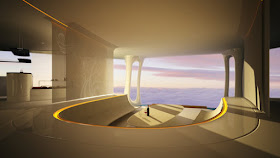Here we see simple robotically guided geometry used to create rather lifelike flying motion. As we speak, thousands of rich kids throughout the world are in the process of getting inspired to get and tinker with these as toys. This will lead to serious efforts to bring about "air yachts" and "air hotels" in the 2020s.
In the meantime, we will see the kite reimagined so increasingly sophisticated floating robotic critters follow you around as you walk. Singing to you? Impressing you with laser/strobe light displays? Fetching for you? Don't get us started on the quadrocopters (which are not relevant to FHP due to being descendants of the helicopter yet are still relevant in inspiring the minds of young future oligarchs).
Solar technology to power water/oxygen to hydrogen is getting more efficient all the time so the first air yachts and medium sized luxury air toys will be able to land on water to refuel.
The effect when unleashed into the public is rather impressive as humans appear to be innate toolmakers and take delight in overcoming nature.
A number of prominent people in the industry are already designing entire flying hotels. The rapidly growing amount of bourgeois customers across the globalizing world certainly points to a solid self-sustaining potential market. The multiple efforts to develop and reimagine futuristic gas based floating giants will lead to smaller spin offs using more exotic technologies later in this century (focus of this blog). Most of the flying hotels on the drawing board look like 21st century neo-Zeppelins but some take new aerodynamic directions as shown below:
There is also a tendency towards a flying saucer look, possibly stabilized along 4 corners the way a quadrotor vehicle is.
Experiments with biology-inspired gas fueled objects also have some potential for unique steering when scaled up.





















































